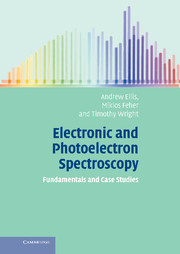Book contents
- Frontmatter
- Contents
- Preface
- List of journal abbreviations
- Part I Foundations of electronic and photoelectron spectroscopy
- 1 Introduction
- 2 Electronic structure
- 3 Angular momentum in spectroscopy
- 4 Classification of electronic states
- 5 Molecular vibrations
- 6 Molecular rotations
- 7 Transition probabilities
- Part II Experimental techniques
- Part III Case Studies
- Appendix A Units in spectroscopy
- Appendix B Electronic structure calculations
- Appendix C Coupling of angular momenta: electronic states
- Appendix D The principles of point group symmetry and group theory
- Appendix E More on electronic configurations and electronic states: degenerate orbitals and the Pauli principle
- Appendix F Nuclear spin statistics
- Appendix G Coupling of angular momenta: Hund's coupling cases
- Appendix H Computational simulation and analysis of rotational structure
- Index
- References
4 - Classification of electronic states
Published online by Cambridge University Press: 05 June 2012
- Frontmatter
- Contents
- Preface
- List of journal abbreviations
- Part I Foundations of electronic and photoelectron spectroscopy
- 1 Introduction
- 2 Electronic structure
- 3 Angular momentum in spectroscopy
- 4 Classification of electronic states
- 5 Molecular vibrations
- 6 Molecular rotations
- 7 Transition probabilities
- Part II Experimental techniques
- Part III Case Studies
- Appendix A Units in spectroscopy
- Appendix B Electronic structure calculations
- Appendix C Coupling of angular momenta: electronic states
- Appendix D The principles of point group symmetry and group theory
- Appendix E More on electronic configurations and electronic states: degenerate orbitals and the Pauli principle
- Appendix F Nuclear spin statistics
- Appendix G Coupling of angular momenta: Hund's coupling cases
- Appendix H Computational simulation and analysis of rotational structure
- Index
- References
Summary
The partitioning of electrons into molecular orbitals (MOs) provides a useful, albeit not exact, model of the electronic structure in a molecule. The MO picture makes it possible to understand what happens to the individual electrons in a molecule. Taking the electronic structure as a whole, a molecule has a certain set of quantized electronic states available. Electronic spectroscopy is the study of transitions between these electronic states induced by the absorption or emission of radiation. Within the MO model an electronic transition involves an electron moving from one MO to another, but the concept of quantized electronic states applies even if the MO model breaks down.
Different electronic states are distinguished by labelling schemes which, at first sight, can seem rather mysterious. However, understanding such labels is not a difficult task once a few examples have been encountered. We begin by considering the more familiar case of atoms, before moving on to molecules.
Atoms
If we accept the orbital approximation, then the starting point for establishing the electronic state of an atom is the distribution of the electrons amongst the orbitals. In other words the electronic configuration must be determined. Individual atomic orbitals are given quantum numbers to distinguish one from another, leading to labels such as 1s, 3p, 4f, and so on. The number in each of these labels specifies the principal quantum number, which can run from 1 to infinity.
- Type
- Chapter
- Information
- Electronic and Photoelectron SpectroscopyFundamentals and Case Studies, pp. 15 - 23Publisher: Cambridge University PressPrint publication year: 2005



